Solution structure of the 128 kDa enzyme I dimer from Escherichia coli and its 146 kDa complex with HPr using residual dipolar couplings and small- and wide-angle X-ray scattering
- PMID: 20731394
- PMCID: PMC2955445
- DOI: 10.1021/ja105485b
Solution structure of the 128 kDa enzyme I dimer from Escherichia coli and its 146 kDa complex with HPr using residual dipolar couplings and small- and wide-angle X-ray scattering
Abstract
The solution structures of free Enzyme I (EI, ∼128 kDa, 575 × 2 residues), the first enzyme in the bacterial phosphotransferase system, and its complex with HPr (∼146 kDa) have been solved using novel methodology that makes use of prior structural knowledge (namely, the structures of the dimeric EIC domain and the isolated EIN domain both free and complexed to HPr), combined with residual dipolar coupling (RDC), small- (SAXS) and wide- (WAXS) angle X-ray scattering and small-angle neutron scattering (SANS) data. The calculational strategy employs conjoined rigid body/torsion/Cartesian simulated annealing, and incorporates improvements in calculating and refining against SAXS/WAXS data that take into account complex molecular shapes in the description of the solvent layer resulting in a better representation of the SAXS/WAXS data. The RDC data orient the symmetrically related EIN domains relative to the C(2) symmetry axis of the EIC dimer, while translational, shape, and size information is provided by SAXS/WAXS. The resulting structures are independently validated by SANS. Comparison of the structures of the free EI and the EI-HPr complex with that of the crystal structure of a trapped phosphorylated EI intermediate reveals large (∼70-90°) hinge body rotations of the two subdomains comprising the EIN domain, as well as of the EIN domain relative to the dimeric EIC domain. These large-scale interdomain motions shed light on the structural transitions that accompany the catalytic cycle of EI.
Figures
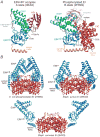




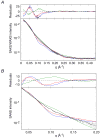

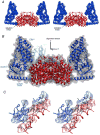
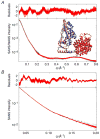
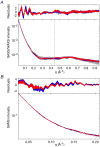
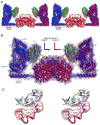
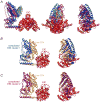
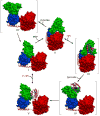
Similar articles
-
Dynamic equilibrium between closed and partially closed states of the bacterial Enzyme I unveiled by solution NMR and X-ray scattering.Proc Natl Acad Sci U S A. 2015 Sep 15;112(37):11565-70. doi: 10.1073/pnas.1515366112. Epub 2015 Aug 24. Proc Natl Acad Sci U S A. 2015. PMID: 26305976 Free PMC article.
-
Solution NMR structure of the 48-kDa IIAMannose-HPr complex of the Escherichia coli mannose phosphotransferase system.J Biol Chem. 2005 May 27;280(21):20775-84. doi: 10.1074/jbc.M501986200. Epub 2005 Mar 23. J Biol Chem. 2005. PMID: 15788390 Free PMC article.
-
Crystal structure of enzyme I of the phosphoenolpyruvate sugar phosphotransferase system in the dephosphorylated state.J Biol Chem. 2009 Nov 27;284(48):33169-76. doi: 10.1074/jbc.M109.057612. Epub 2009 Sep 28. J Biol Chem. 2009. PMID: 19801641 Free PMC article.
-
Three-dimensional structures of the central regulatory proteins of the bacterial phosphotransferase system, HPr and enzyme IIAglc.J Cell Biochem. 1993 Jan;51(1):75-82. doi: 10.1002/jcb.240510114. J Cell Biochem. 1993. PMID: 8432747 Review.
-
Hybrid Approaches to Structural Characterization of Conformational Ensembles of Complex Macromolecular Systems Combining NMR Residual Dipolar Couplings and Solution X-ray Scattering.Chem Rev. 2016 Jun 8;116(11):6305-22. doi: 10.1021/acs.chemrev.5b00592. Epub 2016 Jan 7. Chem Rev. 2016. PMID: 26739383 Free PMC article. Review.
Cited by
-
Biophysical characterization of the domain association between cytosolic A and B domains of the mannitol transporter enzymes II(Mtl) in the presence and absence of a connecting linker.Protein Sci. 2016 Oct;25(10):1803-11. doi: 10.1002/pro.2988. Epub 2016 Aug 1. Protein Sci. 2016. PMID: 27438678 Free PMC article.
-
A Time-Dependent Quantum Approach to Allostery and a Comparison With Light-Harvesting in Photosynthetic Phenomenon.Front Mol Biosci. 2020 Aug 28;7:156. doi: 10.3389/fmolb.2020.00156. eCollection 2020. Front Mol Biosci. 2020. PMID: 33005625 Free PMC article.
-
Solution structure of the IIAChitobiose-HPr complex of the N,N'-diacetylchitobiose branch of the Escherichia coli phosphotransferase system.J Biol Chem. 2012 Jul 6;287(28):23819-29. doi: 10.1074/jbc.M112.371492. Epub 2012 May 16. J Biol Chem. 2012. PMID: 22593574 Free PMC article.
-
Determination of solution structures of proteins up to 40 kDa using CS-Rosetta with sparse NMR data from deuterated samples.Proc Natl Acad Sci U S A. 2012 Jul 3;109(27):10873-8. doi: 10.1073/pnas.1203013109. Epub 2012 Jun 25. Proc Natl Acad Sci U S A. 2012. PMID: 22733734 Free PMC article.
-
Polymer-Nanodiscs as a Novel Alignment Medium for High-Resolution NMR-Based Structural Studies of Nucleic Acids.Biomolecules. 2022 Nov 3;12(11):1628. doi: 10.3390/biom12111628. Biomolecules. 2022. PMID: 36358983 Free PMC article.
References
-
- Meadow ND, Fox DK, Roseman S. Annu Rev Biochem. 1990;59:497–542. - PubMed
-
- Robillard GT, Broos J. Biochim Biophys Acta. 1999;1422:73–104. - PubMed
-
- Siebold C, Flukiger K, Beutler R, Erni B. FEBS Lett. 2001;504:104–111. - PubMed
-
- Weigel N, Waygood EB, Kukuruzinska MA, Nakazawa A, Roseman S. J Biol Chem. 1982;257:14461–14469. - PubMed
Publication types
MeSH terms
Substances
Grants and funding
LinkOut - more resources
Full Text Sources
Other Literature Sources
Molecular Biology Databases
Miscellaneous

